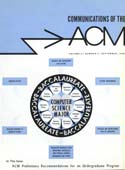September 1965 - Vol. 8 No. 9

Features
An undergraduate program in computer science—preliminary recommendations
The Curriculum Committee on Computer Science (C3S) of the Association for Computing Machinery has been considering curriculum problems for approximately three years. During the early part of this period, a number of informal sessions were held with computer people at various national meetings. In the latter part of this three-year period, the Committee has been formally organized and has made a definite effort to arrive at a concrete suggestions for a curriculum.
ACM proposes to republish contents of Communications Algorithms section is useable looseleaf format, with bimonthly updating service, provided there is sufficient demand. For details, see News item on page 583.
On reversible subroutines and computers that run backwards
A computer design is described which permits subroutines to be executed backward as well as forward, either with their instructions unchanged or replaced with conjugate instructions. It is shown that using this concept a number of new subroutine types can be developed with rather unusual properties. Since these properties are analogous to certain matrix operations, a arallel nomenclature is suggested for their classification.
A computer center simulation project
Today's computation centers are based on rapidly changing technologies of hardware and software systems. It is difficult, therefore, to base decisions on experience; in most instances, the benefits of comparable experience for a given problem situation are not available. In this paper, a mathematical model of the Lockheed Central Computer Center is formulated that describes the operation of a computation center in terms of information nets, decision processes, and control functions. Experiments performed with this model, the results of the experiments, and the application of the results are discussed.
Finding zeros of a polynomial by the Q-D algorithm
A method which finds simultaneously all the zeros of a polynomial, developed by H. Rutishauser, has been tested on a number of polynomials with real coefficients. This slowly converging method (the Quotient-Difference (Q-D) algorithm) provides starting values for a Newton or a Bairstow algorithm for more rapid convergence.
Necessary and sufficient conditions for the existence of the Q-D scheme are not completely known; however, failure may occur when zeros have equal, or nearly equal magnitudes. Success was achieved, in most of the cases tried, with the failures usually traceable to the equal magnitude difficulty. In some cases, computer roundoff may result in errors which spoil the scheme. Even if the Q-D algorithm does not give all the zeros, it will usually find a majority of them.
Applications of differential equations in general problem solving
A large class of problems leading to digital computer processing can be formulated in terms of the numerical solution of systems of ordinary differential equations. Powerful methods are in existence for the solution of such systems. A good general purpose routine for the solution of such systems furnishes a powerful tool for processing many problems. This is true from the point of view of ease of programming, ease of debugging, and minimization of computer time. A number of examples are discussed in detail.
UPLIFTS—University of Pittsburgh linear file tandem system
A series of computer programs has been developed and is now operational for processing the National Aeronautics and Space Administration linear file system on an IBM 1401-7090 combined data processing system. The programs are noteworthy in that they create fixed length logical records and fixed length blocks from variable length source data, and format the output for optimization of processing on the IBM 7090 system. The programs are completely self-checking and test for both validity and accuracy of the input materials as provided by the National Aeronautics and Space Administration.



